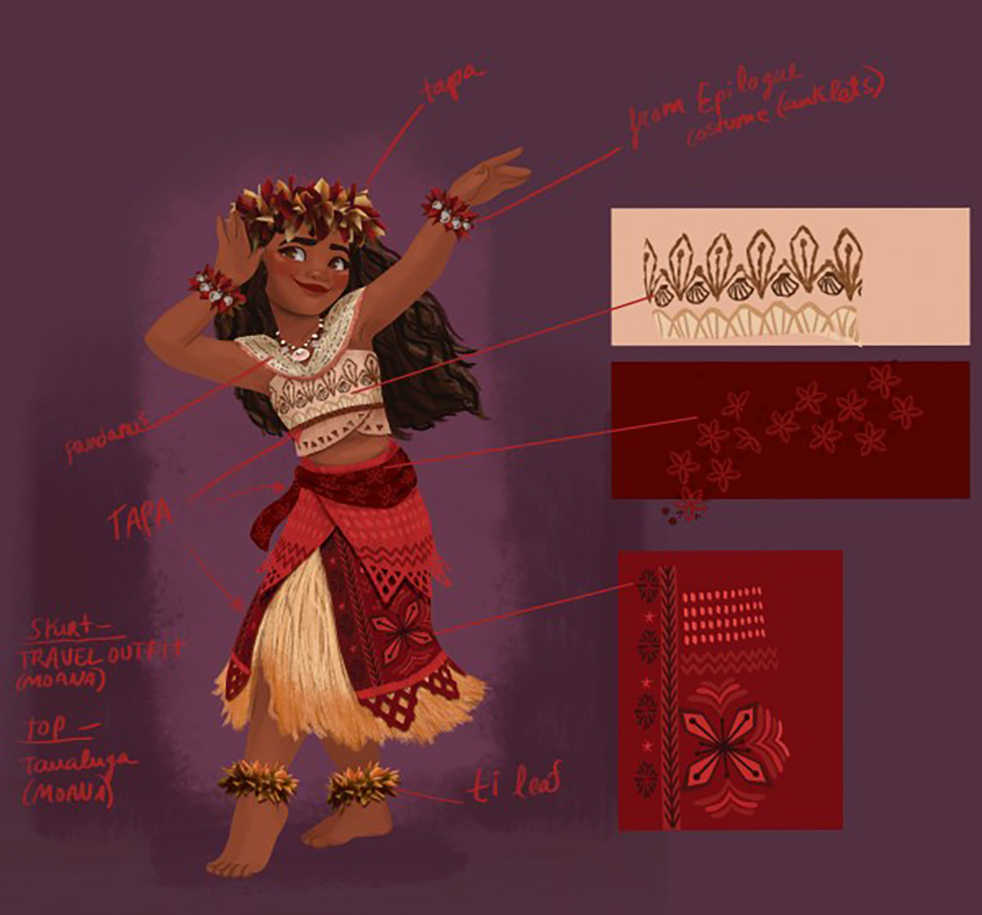Neysa Bové is one of few people who can claim to be creating Disney magic. The artist is currently visiting schools across the U.S. as part of a promotional tour for “Moana.”
Bové is responsible for the newest animated princess’ intricate costuming, as well as that of her demigod co-lead, her family and fellow villagers on a nameless Polynesian island thousands of years in the past. On Nov. 3, just prior to giving an hour-long presentation of behind-the-scenes clips and renderings to students, Bové sat down with
the Technique.
While Moana is Bové’s first foray into costume design for film, it is neither her first work with Disney nor her first time designing fashion.
“I went to school for fashion design, and I was studying a little bit of animation in some classes … I worked in the fashion industry for a little bit, and I made my way to the toy industry designing Barbie dolls. Again, I had no idea how to do it, but they gave me chances and I took them and made sure to work my ass off and make it happen. While I was there I got a phone call from Disney because they were looking at my portfolio online and … I put together a portfolio for them for costume design, and went through five interviews with them, which was super stressful. But they called me back and gave me the job.”
Though the film is a work of fiction, much of the mythos in the storyline is drawn from real Pacific Island legends. Therefore, it is critical to the filmmakers that respects be paid to historical accuracy, even down to costuming.
To assist Bové with her job, the Pacific Trust sent representatives to Disney with authentic textile samples that would have been present in ancient Polynesia. Two major materials, tapa and pandanus, are the basis for most costumes in the film.
“Because the materials are natural, they tend to be more structured than a fabric,” said Bové. “How they move on people, and how they move when wet is different and it’s important to get those things right.”
The character design of Moana herself received much attention following her unveiling, with many praising her more realistic and athletic build as compared to past Disney heroines.
“For Moana’s costume I knew she was an adventurer, a voyager, and the costume had to reflect that,” said Bové. “I added a slit to the front of her skirt, which ended up working technically as well. We work very closely to the animation department and the simulation team. … Whatever outfit she wears needs to be historically correct, it needs to have materials that are accurate to the history, and it has to allow movement.”
Though functional at first, Moana’s ensembles are also aesthetically appealing. The bodice of her “traveler’s outfit,” or the burnt-orange top with the slitted skirt, is embellished with snail shells. Seen for mere seconds of the film, a more formal look emphasizes red — a color signifying regality and royalty in the Pacific islands — and features ornate embroidery and handcrafted accessories.
Disney began marketing “Moana” merchandise several months ago, including Halloween costumes that proved quite popular without the film even having been released yet. Though not explicitly part of her job, Bové considered how her work would translate to the real world as well.
“When I’m designing something there’s a lot of considerations: is this authentic to the character and their personality … [And] would little girls want to wear this? How would this look on someone who’s not the character? I think [girls dressing as Moana for Halloween already] is so incredible,” Bové said.
To save her island, Moana teams up with the macho demigod, Maui. Though legendary for his heroism and shape-shifting, Maui’s luck has taken a turn by the time Moana meets him.
“Maui has been stranded on an island for a thousand years, so he’s wearing things that he would have been able to find there,” Bové said, referencing Maui’s primary costume of a pandanus skirt. “His necklace is things he could find on the beach or on the island. It looks handmade and it suits him physically because it’s a large piece, sort of chunky, and it looks heavy when it moves.”
Students at the presentation also viewed basic animations of some supporting characters, Pu’a the pig and Hei Hei the rooster, as well as for Moana’s father. These animations, called calisthenics tests, aim to demonstrate the range of motion of a character’s model before scenes are worked on. For Pu’a, the clip demonstrated how a scratch from his back hoof would ruffle shoulder fur.
“That poor effects team. There are lava monsters. Water is a character in this movie. I would walk down the hallway, and I would see a whiteboard with equations and stuff. I’m not kidding. We have computer scientists at the studio, and a lot of people we hire from outside temporarily for each film. They have to develop a lot of programs, even for hair.”
Bové went on to describe a program called Quicksilver, which was developed for “Moana” with an unprecedented purpose in mind: creating more realistic human hair, with enough weight and fine detail that a character’s fingers can run through it.
“Moana” will be released nationally on Nov. 23 and features the voice talents of newcomer Auli’i Cravalho and Dwayne “The Rock” Johnson (“Fast & Furious 6”), direction by Ron Clements (“The Little Mermaid”) and John Musker (“The Little Mermaid”) and music by Opetaia Foa’i, Mark Macina (“The Lion King”) and Lin-Manuel Miranda (“In the Heights”).
